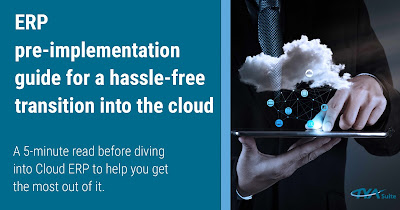Before we implement Cloud ERP
 |
| Before we implement CloudERP |
Pre-Implementation Guide: Your go to for a hassle free ERP transition.
Cloud based ERP is being recognized by all businesses across all segments rapidly and is becoming the number one choice for business management. Cloud software’s are agile, easy to deploy and easy to upgrade, there are numerous other benefits that it brings with itself.
Moving from an on-premise ERP to cloud could be challenging, even hectic at times. However, with careful planning prior to the big move and a solid strategy in place, implementations can do wonders and result in a successful ERP project.
Fundamentally, it is crucial to understand the striking contrasts between cloud ERP and on-premise ERP systems to determine which one is best suited for your business.
- The foundational distinction between Cloud and ERP – At the crux of it, cloud would refer to ERP systems being hosted by your vendor/partner on his servers. If the physical server would be located at your office premise, that would qualify to be a on-premise ERP system.
In cloud ERP scenario, the vendor is responsible for maintenance and upgrade of ERP system throughout the duration of its use.
As a chain-effect, everything from rate of deployment to costs would differ based on the model your business chooses to go forward with.
Mobility? Speedy deployment and accessibility? Cloud ERP just might be able to lend you a hand when it comes to these.
Sense of security and reserved access? On-premise could do a better job at these.
Constructing a clear sense of what cloud computing is all about is essential before taking the plunge into the ERP world.
- Communicating change company-wide: Approval from management to implement an ERP is not the final step, rather the opposite. It marks the inception of a much larger responsibility i.e communicating they “why” and “how” of ERP among employees across all level within the organization.
Your argument should revolve around the value that it brings to the company. Summarize ways in which your company will benefit by improving staff productivity using automation to reduce redundant and monotonous tasks.
If the company leaders are on board entirely with the idea, they can spark members across the company to give the system a try while also explaining how it can be beneficial to reduce their workload in the bigger picture.
- Change Management planning: As humans we tend to get attached and most often very comfortable and dread change, this is applicable even in the case of ERP change i.e the big move from on-premise to Cloud ERP.
Rebuttals from fellow employees, management and much more can be catastrophic if it isn’t handled with care. Gartner surveys reveled that as many as 75% ERP project failures are a result of lack of co-ordination and support from employees towards the software and lack of willingness to adopt it with a positive and open mindset.
This why organizational change management is crucial. ERP spreads across all departments across the organization, the change management strategy should layout a strategic framework for all employees across all levels, training plans to familiarize staff with the functionalities, a medium to receive feedback and their critical analysis post training should all ideally be a part of the strategy.



Comments
Post a Comment